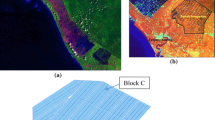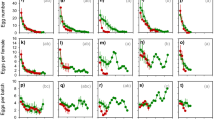Abstract
Brown planthopper (BPH), Nilaparvata lugens (Stal.) development studied at six constant temperatures, 19, 22, 25, 28, 31 and 33 ±1 °C on rice plants revealed that developmental period from egg hatching to adult longevity decreased from 46.8 to 18.4 days as temperature increased from 19 to 31 °C. Through regression of development rate on temperature, thermal constant of small nymph (1st-2nd instar), large nymph (3rd–5th instar) and adult were determined to be 126.6, 140.8 and 161.3 degree days (DD), respectively with corresponding development threshold being 8.8, 9.5 and 9.6 °C. A thermal constant-based mechanistic-hemimetabolous-population model was adapted for BPH and linked with InfoCrop, a crop simulation model to simulate climate change impact on both the pest population and crop-pest interactions. The model was validated with field data at New Delhi and Aduthurai (Tamil Nadu, India), (R 2 = 0.96, RMSE = 1.87 %). Climate-change-impact assessment through coupled BPH-InfoCrop model, in the light of the projected climate-change scenario for Indian subcontinent, showed a decline of 3.5 and 9.3–14 % in the BPH population by 2020 and 2050, respectively, during the rainy season at New Delhi, while the pest population exhibited only a small decline of 2.1–3.5 % during the winter at Aduthurai by 2050. BPH population decline is attributed to reduction in fecundity and survival by simulation model, which otherwise was not possible to account for with an empirical model. Concomitant to its population decline, BPH-induced yield loss also indicated a declining trend with temperature rise. However, the study considered the effect of only CO2 and temperature rise on the BPH population and crop yield, and not that of probable changes in feeding rate and adaptive capacity of the pest.








Similar content being viewed by others
Explore related subjects
Discover the latest articles and news from researchers in related subjects, suggested using machine learning.References
Aggarwal PK, Kalra N, Chander S, Pathak H (2006) InfoCrop: a dynamic simulation model for the assessment of crop yields, losses due to pests, and environmental impact of agro-ecosystems in tropical environments. I. Model description. Agric Syst 89:1–25
Anonymous (2010) Agriculture. In: India 2010 a reference manual. Ministry of Information and Broadcasting. Govt. of India, New Delhi, 61 pp
Bae SH, Pathak MD (1970) Life history of Nilaparvata lugens and susceptibility of rice varieties to its attacks. Ann Entomol Soc Am 63(1):149–155
Bae SD, Song YH, Park YD (1987) Effects of temperature conditions on the growth and oviposition of brown planthopper. Korean J Plant Prot 26(1):13–23
Bentur JS, Kalode MB (1985) Natural enemies of leaf and planthoppers in Andhra Pradesh. Entomon 10(4):271–274
Butturini A, Tiso R, Molinari F (2000) Phenological forecasting model for Cydia funebrana. Bull OEPP 30:131–136
Cheng JA, Holt J (1990) A systems approach to brown planthopper control on rice in Zhejiang province, China. I. Simulation of outbreaks. J Applied Ecol 27(1):85–99
Cook AG, Perfect TJ (1985) The influence of immigration on population development of Nilaparvata lugens and Sogatella furcipera and its interaction with immigration by predators. Crop Prot 4(4):423–433
Ding ZZ, Chen ML, Li PY (1981) The reproductive rate and economic threshold of the brown planthopper, Nilaparvata lugens Stal. Acta Entomol Sin 24:152–159
Goudriaan J, Van Laar HH (1994) Modelling crop growth processes. Kluwer, Dordrecht, The Netherlands, pp 219–236
Graf B, Lamb R, Heong KL, Fabellar L (1992) A simulation model for population dynamics of rice leaf folders and their interaction with rice. J Applied Ecol 29:558–570
Guang HS, Cheng XN, Zhang XX (2000) Simulation on developmental and survival rate of brown planthopper nymphs. Chin J Rice Sci 14(3):157–160
Heong KL (1982) Population model of the brown planthopper, Nilaparvata lugens. MARDI Res Bull 10:195–209
Hilbert DW (1995) Growth based approach to modeling the development rate of arthropods. Environ Entomol 24:771–778
Ho HS, Liu TH (1969) Ecological investigation on brown planthopper in Taichung district. Plant Protec Bull (Taiwan) 11(1):33–42
Holt J, Cook AG, Perfect TJ, Norton GA (1987) Simulation analysis of brown population dynamics on rice in the Philippines planthopper dynamics on rice. J Applied Ecol 24:87–102
Kipyatkov VE, Lopatina EB (2010) Intraspecific variation of thermal reaction norms for development in insects: new approaches and prospects. Entomol Rev 89:33–61
Krishnaiah NV, Ramaprasad AS, Raghavendrarao C, Pasalu IC, Lakshmi VJ, Lakshminarayana V, Raju G (2005) Effects of constant and variable temperatures on biological parameters of rice brown planthopper, Nilaparvata lugens. Indian J Plant Prot 33(2):181–187
Krishnaiah NV, Ramaprasad AS, Raghavendrarao C, Pasalu IC, Zaheeruddeen SM, Verma NRG, Lakshmi VJ, Raju G (2006) Population dynamics of rice brown planthopper, Nilaparvata lugens in Godavari delta of Andhra Pradesh. Indian J Plant Prot 34(2):158–164
Krishnaiah NV, Lakshmi VJ, Pasalu IC, Katti GR, Padmavathi C (2008) Insecticides in rice: IPM, past, present and future. Directorate of Rice Research, ICAR, Hyderabad, India, 148 pp
Kropff MJ, Teng PS, Rabbinge R (1995) The challenge of linking pest to crop models. Agric Syst 49:413–434
Lal M, Nozawa T, Emori S, Harasawa H, Takahashi K, Kimoto M, Abe-Ouchi A, Nakajima T, Takemura T, Numaguti A (2001) Future climate change: implications for Indian summer monsoon and its variability. Curr Sci 81:1196–1207
Pathak MD (1968) Ecology of common insect pests of rice. Ann Rev Entomol l3:257–294
Pinnschmidt HO, Batchelo WD, Teng PS (1995) Simulation of multiple species pest damage in rice using CERES-rice. Agric Syst 48:193–222
Rabbinge R, Rossing WAH, van der Werf W (1994) Systems approaches in pest management: the role of production ecology. In: Rajan A, Ibrahim Y (eds) Proceedings of the Fourth International Conference on Plant Protection in the Tropics. Malaysian Plant Protection Society, Kuala Lumpur, pp 25–46
Rappoldt C, Van Kraalingen DWG (1996) The Fortran Simulation Translator FST version 2.0: quantitative approaches in system analysis no. 5. Introduction and reference manual. C. T. de Wit Graduate School for Production Technology, Wageningen University, Wageningen, The Netherlands, 178 pp
Reji G, Chander S (2008) A degree-day simulation model for the population dynamics of the rice bug, Leptocorisa acuta. J Applied Entomol 132(8):646–653
Reji G, Chander S, Aggarwal PK (2008) Simulating rice stem borer, Scirpophaga incertulas Walker damage for developing decision support tools. Crop Prot 27(8):194–199
Safranyik L, Barclay H, Thomson A, Riel WG (1999) A population dynamics model for the mountain pine beetle, Dendroctonus ponderosae Hopk. (Coleoptera: Scolytidae). Information Report Pacific Forestry Centre, No. BC-X-386, Canadian Forest Service, Victoria, BC, 35 pp
Satake A, Ohgushi T, Urano S, Uchimura K (2006) Modeling population dynamics of a tea pest with temperature dependent development: predicting emergence timing and potential damage. Ecol Res 21:107–116
Srivastava C, Chander S, Sinha SR, Palta RK (2009) Toxicity of various insecticides against Delhi and Palla population of brown planthopper (Nilaparvata lugens). Indian J Agric Sci 79(12):1003–1006
Sujithra M, Chander S, Ravi G (2010) Simulation of Nilaparvata lugens damage in rice. Ann Pl Protect Sci 18(2):315–322
Sutherst RW, Yonow T, Chakraborty S, O’Donnell C, White N (1996) A generic approach to defining impacts of climate change on pests, weeds and diseases in Australasia. In: Bouma WJ, Pearman GI, Manning MR (eds) Greenhouse: coping with climate change. CSIRO, Melbourne, pp 281–307
Teng PS, Batchelor WD, Pinnschmidt HO, Wilkerson GG (1998) Simulation of pest effects on crops using coupled pest-crop models: the potential for decision support. In: Tsuji YG (ed) Understanding options for agricultural production. Kluwer, Dordrecht, The Netherlands, pp 221–226
Uvarov BP (1931) Insects and climate. Trans Ent Soc London 79:1–247
Wareing DR, Holt J, Cheng JA, Norton GA (1990) Use of computer tools for the design of pest management strategies. In: Grayson BT, Green MB, Copping LG (eds) Pest management in rice. Elsevier Applied Science, New York, pp 231–242
Yadav DS, Chander S (2010) Simulation of rice planthopper damage for developing pest management decision support tools. Crop Prot 29:267–276
Acknowledgments
Authors are grateful to Head, Division of Entomology and Post Graduate School, Indian Agricultural Research Institute, New Delhi for financial support for this work.
Author information
Authors and Affiliations
Corresponding author
Electronic supplementary material
Below is the link to the electronic supplementary material.
ESM
(DOC 95 kb)
Rights and permissions
About this article
Cite this article
Sujithra, M., Chander, S. Simulation of rice brown planthopper, Nilaparvata lugens (Stal.) population and crop-pest interactions to assess climate change impact. Climatic Change 121, 331–347 (2013). https://doi.org/10.1007/s10584-013-0878-1
Received:
Accepted:
Published:
Issue Date:
DOI: https://doi.org/10.1007/s10584-013-0878-1




